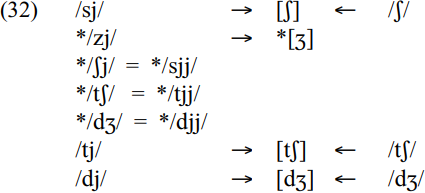


 Grammar
Grammar
 Tenses
Tenses
 Present
Present
 Past
Past
 Future
Future
 Parts Of Speech
Parts Of Speech
 Nouns
Nouns
 Verbs
Verbs
 Adverbs
Adverbs
 Adjectives
Adjectives
 Pronouns
Pronouns
 Pre Position
Pre Position
 Preposition by function
Preposition by function 
 Preposition by construction
Preposition by construction
 Conjunctions
Conjunctions
 Interjections
Interjections
 Grammar Rules
Grammar Rules
 Linguistics
Linguistics
 Semantics
Semantics
 Pragmatics
Pragmatics
 Reading Comprehension
Reading Comprehension
 Teaching Methods
Teaching Methods|
Read More
Date: 2024-04-22
Date: 2024-02-23
Date: 2024-03-14
|
The composition of the onset may be constrained by the nature of the vowel(s) occupying the nucleus. We saw previously on JamC vowels that vocalic sequences /ui/ and /iu/ do not occur. Put another way, however, phonetic [iu] and [ui] sequences are only possible provided the initial vowel in the sequence occupies a C-slot, i.e. functions as the semi-vowels /w/ and /j/ respectively. These produce the phoneme sequences /wi/ and /ju/. This is demonstrated in the following examples.

There is an uneasy relationship between /j/ and /w/ on one hand and their vocalic equivalents, /i/ and /u/, on the other. The occurrence of semi-vowels in the onset is subject to a constraint which follows from their relationship with vocalic segments. Underlyingly, syllable onsets tend not to consist of a semi-vowel as the sole consonant, followed immediately by the vowel which is its vocalic equivalent. This blocks underlying sequences such as */ji/ and */wu/. Where [ji] and [wu] sequences do occur phonetically, it is in variation with a form without the initial semi-vowel, e.g. [unu] ~ [wunu] ‘you (plural)’, [jimba] ~ [imba] ‘a yam variety’ (Cassidy and Le Page 1980: 225, 457).
In JamC, the onset may have a maximum of two consonants. In such combinations, the first item is always an obstruent and the second an approximant. Combinations with /w/ as the second consonant are /pw, bw, tw, dw, kw, w, sw/. Those involving /j/ include /pj, bj, tj, dj, kj, j, fj, vj, sj, mj, nj/. Of these, /tj/, /dj/ and /sj/ do not have transparent realizations at the surface level. The matching phonetic forms, *[tj], *[dj] and *[sj] are blocked, in spite of a contrary suggestion by Wells (1973: 21). They may be blocked because the underlying phoneme sequences /tj/ /dj/ and /sj/ have their surface phonetic manifestations merged by speakers with those of the affricate and fricative consonant phonemes, /ʧ/ , /ʤ/ and /ʃ/ . Both sets of sequences become realized phonetically as [ʧ] , [ʤ] and [ʃ] respectively. The fact is, however, that the consonants /ʧ/ , /ʤ/ and /ʃ/ also occur in the coda, e.g. /matʃ/ ‘match’, /ʤoʤ/ ‘judge’, /jjaʃ/ ‘cash’. This establishes that [ʧ] , [ʤ] and [ʃ] can and do represent the consonant phonemes /ʧ/ , /ʤ/ and /ʃ/ rather than just underlying /tj/, /dj/ and /sj/. We suggest nevertheless that in the onset, speakers do treat [ʧ] , [ʤ] and [ʃ] as representing a merger at the phonetic level between [ʧ] , [ʤ] and [ʃ] , on one hand, and /tj/, /dj/ and /sj/ on the other.
The only consonants occurring in the JamC onset which are blocked from occurring before /j/ are /l/, /r/, /z/, /ʃ/ , /ʧ/ and /ʤ/. Given the position of /l/ and /r/ in the sonority hierarchy, we may regard them as sonorant consonants which, like /j/ and /w/, only occur in second position in the onset. An onset */zj/ cluster fails to occur because it cannot be phonetically reinterpreted. The expected form, * /Ʒ/, does not exist as a phoneme in JamC. The blocking of */ʃj/ , */tʃj/ * /ʤj/and are, we would suggest, the result of the unacceptability of the alternative /sjj/, /tjj/ and /djj/ underlying representation. These would require a */jj/ sequence. The analysis is presented below.

The apparent occurrence of /dj/ on the surface as in /djam/ ‘damn’ really involves a disyllabic sequence /dijam/, with prominence on the second syllable.
|
|
|
|
لشعر لامع وكثيف وصحي.. وصفة تكشف "سرا آسيويا" قديما
|
|
|
|
|
|
|
كيفية الحفاظ على فرامل السيارة لضمان الأمان المثالي
|
|
|
|
|
|
|
المشاريع الهندسية: المواد الأولية المستخدمة في مشاريع العتبة العباسية المقدسة مطابقة للمواصفات العراقية
|
|
|